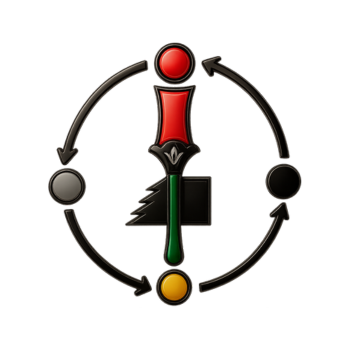-
Within Afrikan history (across the continent) the handling of beads is as old as mankind itself. For the Ndebele of South Afrika, here beads and beadwork touch on every item found in their lives til this very day. Therefore highly mathematical calculations were very important from a young age. The history of the Ndebele people indicates that they were never exposed to schools during their early years of their development, therefore had not been schooled to be able to do sophisticated mathematical calculations. However, basic mathematical operations such as addition and subtraction were their daily exercise.
The very ability to calculate was limited to counting the cattle and other household stock. Simple counting that is addition and subtraction was thus their daily bread. It is however this counting that plays one of the most important parts in the art of beadwork. To string down beads onto a piece of leather so as to produce a figure requires accurate calculations involving simple addition and/or subtraction. It is these very simple mathematical operations that were used and are still used by the Ndebele artists in producing all worldwide famous geometric figures that have made Ndebele beadwork so popular to the extent of receiving international accolades. A Ndebele artist is therefore able to produce right angled figures, triangular shaped figures as well as circular figures.
All these are used as decorative figures on the work of art. All these figures depend entirely on the artists ability to calculate correctly the number of beads needed in order to construct a particular figure. Generally speaking, most observers and researchers on Ndebele beadwork agree that Ndebele males are never not involved in the making of beadwork articles. They are only found to be users of beadwork. Even the wearing of the beadwork articles is a lot less than is the case with the women. However, just like in women, the males live their whole lives surrounded and embedded by beads.With all bead making there is an appropriate skill that is needed to make a type of item. Each takes great time and effort, the time taken on an item depends on how sophisticated the item is.
2 Comments-
 119,738
Abibisika (Black Gold) Points
119,738
Abibisika (Black Gold) Points
BlackTiful images. Do they make the beads themselves?
-
As you know there are many types of beads which are African in origin. These glass beads however is still being debated till this very day as it is not possible to say with precision when and where these beads originated from. But research by our scholars have indicated one source that these glass beads were brought to Southern Afrika during the Arab Slave Trade, Persia, Portuguese, Dutch and the English as a trade item available. It must be noted that the Afrikan man developed skills in glass making before any kind of outside influence especially in West Afrika where there is an abundance of evidence (which must be considered valid information) and where there is evidence of iron and brass that was used as ornaments in Southern Afrika (Xhosa), there just does not seem to be any evidence found of glass being used in this region. Whether internal trade or outside influence Teacher these glass beads have brought a radical transformation of the Ndebele people in regards to their economy, practical usages and cultural appearances. Again quickly to add which is important to know, there are still many from the Ndebele community that still stick to their tradition of making their beads with Ostrich Eggs, Dry Seeds, Animal Teeth. Seashells etc.. which all hold mystical, magical and medicinal purposes. Ever so sorry for the late response but have been detoxing / self reflecting during this time.
-
-

